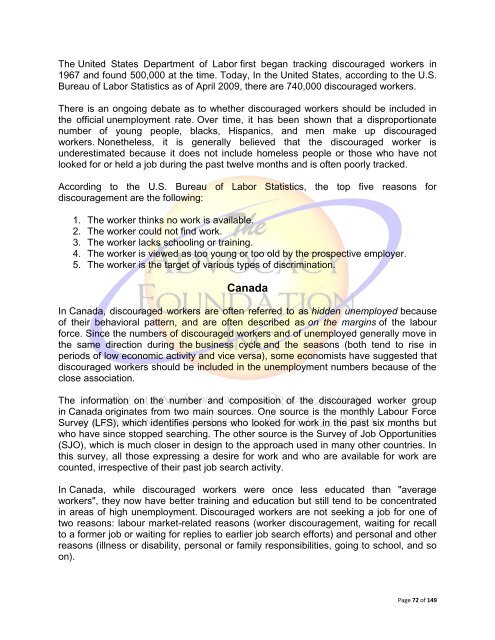Hidden Unemployment
Hidden Unemployment
Hidden Unemployment
You also want an ePaper? Increase the reach of your titles
YUMPU automatically turns print PDFs into web optimized ePapers that Google loves.
The United States Department of Labor first began tracking discouraged workers in<br />
1967 and found 500,000 at the time. Today, In the United States, according to the U.S.<br />
Bureau of Labor Statistics as of April 2009, there are 740,000 discouraged workers.<br />
There is an ongoing debate as to whether discouraged workers should be included in<br />
the official unemployment rate. Over time, it has been shown that a disproportionate<br />
number of young people, blacks, Hispanics, and men make up discouraged<br />
workers. Nonetheless, it is generally believed that the discouraged worker is<br />
underestimated because it does not include homeless people or those who have not<br />
looked for or held a job during the past twelve months and is often poorly tracked.<br />
According to the U.S. Bureau of Labor Statistics, the top five reasons for<br />
discouragement are the following:<br />
1. The worker thinks no work is available.<br />
2. The worker could not find work.<br />
3. The worker lacks schooling or training.<br />
4. The worker is viewed as too young or too old by the prospective employer.<br />
5. The worker is the target of various types of discrimination.<br />
Canada<br />
In Canada, discouraged workers are often referred to as hidden unemployed because<br />
of their behavioral pattern, and are often described as on the margins of the labour<br />
force. Since the numbers of discouraged workers and of unemployed generally move in<br />
the same direction during the business cycle and the seasons (both tend to rise in<br />
periods of low economic activity and vice versa), some economists have suggested that<br />
discouraged workers should be included in the unemployment numbers because of the<br />
close association.<br />
The information on the number and composition of the discouraged worker group<br />
in Canada originates from two main sources. One source is the monthly Labour Force<br />
Survey (LFS), which identifies persons who looked for work in the past six months but<br />
who have since stopped searching. The other source is the Survey of Job Opportunities<br />
(SJO), which is much closer in design to the approach used in many other countries. In<br />
this survey, all those expressing a desire for work and who are available for work are<br />
counted, irrespective of their past job search activity.<br />
In Canada, while discouraged workers were once less educated than "average<br />
workers", they now have better training and education but still tend to be concentrated<br />
in areas of high unemployment. Discouraged workers are not seeking a job for one of<br />
two reasons: labour market-related reasons (worker discouragement, waiting for recall<br />
to a former job or waiting for replies to earlier job search efforts) and personal and other<br />
reasons (illness or disability, personal or family responsibilities, going to school, and so<br />
on).<br />
Page 72 of 149

















